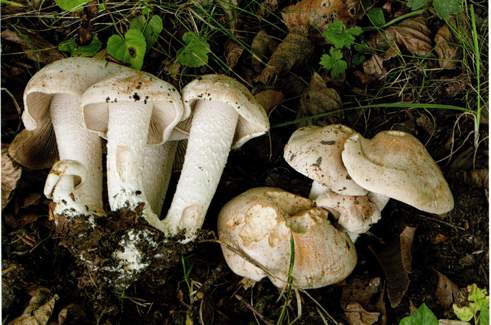 Hebeloma adherens (Photo: C. Monedero)
Hebeloma adherens (Photo: C. Monedero)Taxonomy
Full name: Hebeloma adherens Monedero & P. Alvarado, Yesca 32: 60 (2020)Genus: Hebeloma
Section: Adherentia
Types: SPAIN: Cantabria, Municipio de Campoo de Yuso (approx. 43.0262°N, 4.0055°W, alt. approx. 945 m a.s.l.) on calcareous soil under Fagus sylvatica, 25 Sep. 2019, C. Monedero (HE-250919-01) (Holotype. herbarium acc. no. FCO-Fungi 15, HJB1000581).
- arrow_drop_downarrow_drop_upEtymologyFrom 'adhere' (latin), because cheilocytidia adhere Congo Red.
- arrow_drop_downarrow_drop_upDiagnosisSpecies of Hebeloma growing in groups of 4-5 basidiomata coalescing at the base of their stipes. Pileus covered with a whitish pruine. Spores 8.5 μm long on average, neatly dextrinoid. Cheilocystidia morphologically variable, fixing the Congo Red SDS stain in their center after some hours.
References
Description
- arrow_drop_downarrow_drop_upThresholds
Description of Hebeloma adherens based on 2 collections
- arrow_drop_downarrow_drop_upMacroscopic descriptionPileus: (30) 74 (125) mm diameter; shape convex; characters pruinose, often remains of universal veil; margin characters involute; viscosity tacky when moist; colour variation often unicolour or two color; colour at centre Not recorded.
Lamellae: attachment emarginate; maximum depth up to 8 mm; number of complete lamellae 74–78; presence of tears absent; white fimbriate edge present.
Cortina presence: no.
Stipe: (40) 71 (95) x (8) 15 (21) {median} x (10) 17 (25) {basal} mm; stipe Q 4.5–5.5; base shape often clavate or cylindrical; floccosity floccose, often pruinose; rooting no; thick rhizoids at base absent;
Context: Texture firm; stipe interior hollow; stipe flesh discolouring no; slenderness measure up to 5.4; smell often raphanoid or sacchariolentia; taste weakly bitter where recorded.
Spore deposit colour: Not recorded.
Exsiccata characters: dark, hard, lamellae blackening or pileus blackening.
- arrow_drop_downarrow_drop_upMicroscopic descriptionSpores: shape amygdaloid; colour in microscope yellow brown, often brown; guttules yes. papilla no; Spore Code: O2 O3; P1 P2; D3.
Basidia: 25–32 (33) x 6–8 μm; ave. Q 3.9–4.4; spore arrangement 4 spored;
Cheilocystidia: main shape cylindrical or ventricose, often clavate-lageniform or clavate-ventricose; special features observed often septa; cheilocystidia ratios: A/M = 1.09–1.25; A/B = 0.98–1.16; B/M = 1.11–1.16.
Pleurocystidia: none seen.
Ixocutis: epicutis thickness (measured from exsiccata) up to 150 μm; ixocutis hyphae width up to 7 μm; ixocutis hyphae encrustation variable; shape of trama elements beneath subcutis cylindrical or ellipsoid, often thickly sausage-shaped up to 14 μm wide.
Caulocystidia: Similar to cheilocystidia but larger, up to 125 μm.
- arrow_drop_downarrow_drop_upSpore measurements
- arrow_drop_downarrow_drop_upCheilocystidia measurements
- arrow_drop_downarrow_drop_upHabitat and distributionWhere only one possible associate was recorded, the most commonly recorded associate was Picea (50.0%) but Fagus (50.0%) were also recorded. In these cases the most commonly recorded families were Pinaceae (50.0%) and Fagaceae (50.0%). Overall the most commonly recorded families are Pinaceae (50.0%) and Fagaceae (50.0%) The growth habit of our collections was caespitose.
According to our current collections, the species is found only in Europe. On the continent, collections have been found only in the temperate broadleaf & mixed forests WWF biome The World Wildlife Fund (WWF) have divided the world into 867 terrestrial ecoregions. The ecoregion here is estimated by mapping from the GPS coordinates of the collection using data made available by Dinerstein et al (2017). Use this webtool to explore the ecoregions visually or see a full list of current ecoregions on Wikipedia. (Western European broadleaf forests (50.0%) and Cantabrian mixed forests (50.0%) ecoregions). From collector information, it appears collections have been found in the IUCN habitats We map from the collector's description of the habitat to the International Union for Conservation of Nature (IUCN)'s definition using a standardised set of rules. Please see this page for a full list of IUCN habitats.. Within Europe we have records from the Centre (Switzerland) and the Southwest (Spain). Specimens have been collected from 43.0°N to 46.8°N.
Geographic distribution
Phenology
- arrow_drop_downarrow_drop_upAdditional cited collections